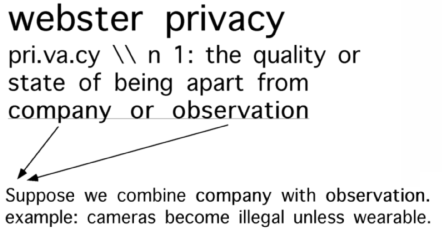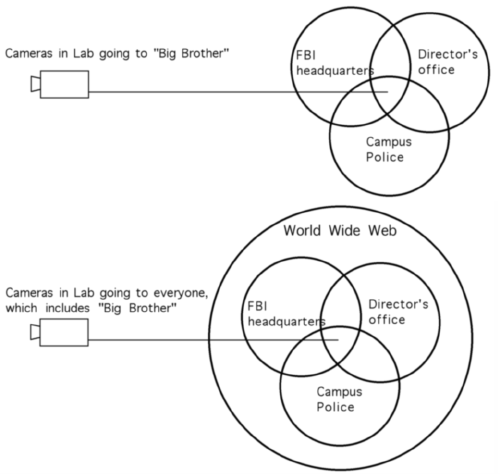
Let us consider Privacy and overtness. Overtness is a measure of how easy it is to know that our privacy is being violated. Take for example the violation of privacy by way of a video camera. Overtness is a measure of how easy it is to see the camera or to discover the video picture signal from the camera, and recognize it as such. In other words, overtness is a measure of how easy it is to know that your privacy is being violated (e.g. when you are or have been captured on video).
One way to achieve overtness would be to require cameras and other machine vision systems to be attached to people:

We already live in a world of ubiquitous surveillance (e.g. smart buildings and smart environments).
Imagine, instead, what it would be like if all cameras that were not attached to people were outlawed. Life would become simpler then: you would pick your nose when nobody was looking (when you were alone). Privacy would be correlated to when you were alone, just like in the dictionary definition above. Privacy is when you are alone. When you're with company, you'd assume you're under observation.
Many people prefer to know when they are on camera (e.g. most people are disturbed more by the prospect of hidden cameras in private places where they might be alone, than by more overt cameras in public places). However, even when the camera is hidden, the signal from the camera might still be made visible to us.
Acquisitional overtness is a measure of how easy it is to determine that there is an acquisition of image information, e.g. loosely speaking, how easy it is to determine the existence of a camera.
Disemenational overtness is a measure of how easy it is to determine that there is a dissemination of image information, e.g. loosely speaking, how easy it is to determine the existence of the picture information (signal) from a camera.
A good example of an acquisitionally covert (hidden), yet disseminationally overt (broadcast) camera is one that is shrouded in secrecy beneath a ceiling dome of wine-dark opacity yet with the signal prominently displayed on a large TV screen hanging from the ceiling at the entrance to a department store.
An example of near zero acquisitional overtness combined with moderate disseminational overtness is the hidden camera in the womens' changeroom at Holy Cross hospital. The camera was discovered, not because someone found the camera itself, but because someone discovered the video signal from the camera. The signal was being distributed within the building so that various people could view it, and it was harder to keep the camera secret as the viewing audience increased in size.
Another factor is the individual nature of the camera, and the good it can do in witnessing dishonesty, police corruption, or human rights violations. For example, the hidden cameras used for investigative journalism often help to bring to light corruption in large organizations. In a sense, such cameras exhibit what I call Sousveillance (the opposite of Surveillance). By Sousveillance, I mean looking from underneath (e.g. individuals looking up at their government or corporations, rather than just having the corporations looking down on them from on high).
While, at first glance, people often express a concern about the dissemination of personal information, one could also argue that this very dissemination enhances privacy, because it brings the violations of privacy to light. Junk mail, unsolicited advertising, and annoying phone calls may actually be a good thing because they continually remind us how much of our personal information is known by other entities.
When we complain about the targeted market junk mail we receive because someone has discovered personal information about us, it is like complaining about the bad smell from our gas stove, rather than complaining about the fact that our stove is leaking. Complaining about the targeted marketing (junk mail, etc.) is like discovering our stove has a gas leak and then asking the gas company to improve the smell of their gas so that it will stop bothering us, instead of fixing the leak. Many of the traditional privacy advocates are doing what is equivalent to asking the government to pass laws to improve the smell of natural gas. These laws will not fix the problem. In fact these laws have the danger of reducing the incentive to fix the problem at its source, e.g. to track down and repair the leaks to our personal information. Similarly, the ``privacy policy'' of many WWW pages affects only disseminational privacy, while preserving acquisitional privacy is the responsibility of the user (e.g. to not give out the information in the first place).
What we really should do is deal with the problem at the source.
Many people make good use of the ``bad smell'' of junk mail for diagnostic purposes, in order to trace back to the source of a privacy leak. They typically do this by using a very simple form of stegonym, such as using a different middle initial for each service they sign up for. Such stegonymous sign--on turns the tables on the organizations by allowing individuals to track organizations through tracking information that individuals can embed in their names or addresses (e.g. for example, by deliberately misspelling their street name, or inserting additional characters into an address field).
Suppose that you, perhaps being a really well known person goes into a department store fitting room where there are hidden cameras. Suppose that it becomes very tempting for the store manager, or some of his employees to distribute this video (e.g. to other employees, or to some of his friends in the police department, with a ``legitimate law enforcement'' justification). While this distribution is in some ways evil, it is the lesser of two evils. The acquisition is the greater of the two evils. Thus dissemination, the lesser of the two evils serves to possibly eliminate acquisition, the greater evil by bringing the entire matter to the attention of the public, and to cause public debate.
If a picture of a famous woman trying on a bikini in a department store fitting room appears in a tabloid newspaper, something would at last be done about these hidden cameras in department store fitting rooms. Either they would be made illegal (or if they were already illegal in the state in question, there would be increased enforcement and action taken against this illegal behaviour), or the bad publicity would cause people to stop shopping there, and the store would go out of business, also putting an end to the problem at its source, and not just the symptom (e.g. like legislation preventing the dissemination of these pictures in tabloid newspapers).

Perhaps it is the fact that any evil that might come from the camera is apt to come right away, rather than years later in the form an accumulation of secret dossiers. If something bad was to be done with the data, then surely it would happen soon, and there would be time to remove the camera before anything more happened. These web cameras are yet another example of the relationship between acquisitional privacy and disseminational privacy. To follow along the gas stove analogy, the leak is more acceptable if we can ``smell'' the leaking information. The public dissemination helps to close the feedback loop and keep us aware of the effect the camera has, and of how the world sees us through the camera.
 .
.